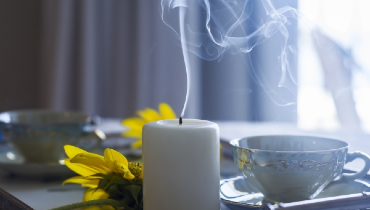Are Candles Bad for Indoor Air Quality?

Candles, most people either love them or hate them—but no matter your feelings, it’s important to acknowledge that they may have a negative impact on the air quality inside your home.
Before you throw out your candle stash, we have recommendations for using candles inside your home. Depending on the candle type, you might still be able to enjoy your favorite pillar or tapers.
Does Burning Candles Affect Air Quality?
Unfortunately, all candles have the potential to negatively impact indoor air quality over time—especially candles made with synthetic fragrance oils and paraffin wax.
The main concern with these materials is the greater production of soot, which according to the Environmental Protection Agency (EPA),may contain phthalates, lead, and volatiles such as benzene and toluene. Airborne soot can irritate respiratory tract, trigger allergy or asthma symptoms. Over time, soot may adhere to air filters and home ventilation systems—negatively impacting air quality.
While frequent candle use may increase soot buildup, and in turn diminish indoor air quality, the EPA concludes there is no direct evidence that candle burning in your home is a health hazard. Rather, you should pay attention to any irritations you experience when using certain candles. If the amount of candle soot is affecting your home air quality and subsequently your health, discontinue use when needed.
Are Any Candles Safe to Burn?
To minimize any harmful effects of scented candles, choose candles that are unscented or naturally scented candles made of:
- Soy wax
- Beeswax
- Palm oil wax
- Vegetable-based wax
- Coconut wax
These candles burn cleaner and longer. Unscented candles typically have a lite, natural fragrance. Alternatively, homeowners seeking an alternative may try wax melts, essential oil diffusers, and DIY natural air fresheners.
Troubled by stubborn or set-in odors? Choose professional odor removal from fellow Neighborly brand, Rainbow International.
Best Practices for Candle Use
If you plan to continue use of candles in your home, to help minimize indoor air pollutants, the Children’s Environmental Health Network advises individuals to:
- Choose candles with a single (ideally pure cotton) wick.
- Trim the wick ¼ inch before lighting to help it burn evenly.
- Pay attention to the burning patterns—the wax should burn evenly.
- Discontinue use of candles that create heavy soot around the container or surrounding area.
- Increase ventilation when burning.
- Only burn candles for 1–2 hours.
We also advise that regardless of candle use, homeowners engage in professional indoor air quality services.
Related Topic: How to Improve Indoor Air Quality
Improve Your Indoor Air Quality
Whether you enjoy the soothing aroma of a scented candle or not, maintaining good indoor air quality requires your attention. The HVAC service professionals at your local Aire Serve are experts when it comes helping homeowners improve and maintain good indoor air quality. To learn more about how you can minimize the presence of indoor allergens, dust, dander, and soot in your home give us a call us, or request an appointment online today.
 Click to call
Click to call


